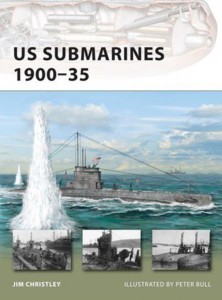 US Submarines 1900-35 by Jim Christley, Osprey Publishing, 2011.
US Submarines 1900-35 by Jim Christley, Osprey Publishing, 2011.
 Defeating the U-Boat: Inventing Antisubmarine Warfare by Jan S. Breemer, Dept. of the Navy, 2010.
Defeating the U-Boat: Inventing Antisubmarine Warfare by Jan S. Breemer, Dept. of the Navy, 2010.
Reviewed by James-Joseph Ahern
Introduced into naval service at the start of the Twentieth-Century, the submarine presented the first threat to the century old concept of the battle fleet as being the primary source of control of the seas. Many naval officers looked down on these small, cramped and smelly boats as little more than coastal defense weapons that had no place in the fleet let alone as a threat to the ever growing behemoths at their center – the battleships. Yet in less than two decades the technological development of submarines on both sides of the Atlantic, along with the practical experience of their crews, had catapulted them into ocean going vessels that almost cost the United Kingdom World War I. Two new works that look at the submarine from a technological perspective as well as a strategic view are Jim Christley’s US Submarines, 1900-35, and Jan S. Breemer’s Defeating the U-boat: Inventing Antisubmarine Warfare.
Christley’s work is a new addition to Osprey Publishing’s New Vanguard series, following that publisher’s well established formula for providing the reader (whether historian or hobbyist) with a well written and thoroughly illustrated reference work. He covers the early period of submarine development in the United States, by examining the technological developments in design, batteries, engines, and armament. During this period submarine design was based on the work of John Philip Holland’s Holland Boat Company (which later became the Electric Boat Company) and Simon Lake’s Lake Torpedo Boat Company. Christley does a nice job of reviewing the technological progression of each company’s designs, as well as the dilemma that was presented to the US Navy in terms of procurement. While Lake’s boats were of a more robust design, they were costly and time consuming to produce in quantity; whereas the Electric Boat designs were sound and better geared towards mass production.
Overall, US Submarines 1900-35 is a wonderful resource for anyone who needs a quick review of the early years of submarine development. While Christley does not provide in depth analysis of how the boats were used by the Navy in the first three and a half decades, he does provide a balanced review of their World War I service. The review of the technical aspects – as well as the visual comparison that is provided – does show the amazing development from the A-class boats to the S-class that saw service up to the early years of World War II.
While the US Navy was learning how to utilize the submarine in the decades prior to the First World War, the Royal Navy was learning the lessons of countering them from 1914 – 1917. While the title of Jan Breemer’s work, Defeating the U-boat: Invention Antisubmarine Warfare, sounds like another technical study of submarine warfare, the focus of the work is the strategic efforts of the Admiralty to defeat the U-boat threat that almost brought England to terms. As Breemer notes, “The tonnage war waged by the U-boats revolutionized naval warfare by rendering obsolete the basic principle of pre-World War I naval thinking (2).” The effort at defeating u-boats was more of a strategic nature that was based on changing the concept of naval warfare then a tactical or technical effort.
As Breemer illustrates, at the start of World War I there was no thorough anti-submarine effort in the Royal Navy. Most officers did not foresee them as a threat to the fleet, and saw the protection of commerce as being outside their intended duty. The dominating theory was that any naval war would be decided in a Trafalgar like battle. By defeating the enemy fleet in a decisive action, the Royal Navy would ensure the protection of not only the British Isles but its seaborne commerce as well. A view shared by the German’s High Seas Fleet as well. However, as history has shown precautionary efforts on both sides prevented that penultimate battle from occurring in the first months of the war. Not until Britain mined the North Sea in order to bottle up the German fleet did the Germans see submarine commerce raiding as an option.
Faced with the reality of commerce raiding, the Admiralty was forced to undertake antisubmarine warfare, which initially took the form of patrols of unarmed auxiliaries. Breemer illustrates the Royal Navy’s efforts to develop weapons to hunt down the u-boats in an offensive campaign. Scientific solutions were tried, but found lacking as naval officers and scientist took differing approaches to a solution. Depth charges were limited in quantity and effectiveness. Mines, nets, and decoy vessels also proved in effective. The missing component to attacking u-boats was a reliable method to find them. Room 40 intelligence could accurately track the area where u-boats were patrolling, but not with enough accuracy to pin point their location. Correspondingly, the initial U-boat offensives were limited by the Rules of Engagement set by the Germans, resulting in the tonnage being sunk appearing minimal.
The start of unrestricted submarine warfare by the Germans in 1917 had the desired effect on British shipping. U-boats were able to sink significant tonnage, or in the less damage ships which then required 5-6 months of repair, or were beyond repair. During this time Breemer shows how The Admiralty still discredited convoying on the basis that there were not enough escort ships for each convoy, and that merchant ships could not steam in the necessary formation. However, these were bases on fleet tactics, not the real necessity of convoying merchant ships. Moreover, the statistical information regarding tonnage sunk that the Admiralty was presenting did not paint the true dire nature of the u-boat offensive. It was not until two junior officers, Reginald Henderson and Kenneth G. B. DeWar, sought information on shipping losses outside of the established chain of command and the presented the true results to the British Government that actual attempts at convoying merchant ships was tried. In the end, convoying proved more successful at defeating the u-boats then any offensive method tried by the Royal Navy.
The overall argument that Breemer illustrates is that despite the Royal Navy being a cutting edge force, they were dominated by officers who did not take to interference from outside the ranks, and looked to traditional offensive solutions to problems – most notably submarines – as opposed to solutions beyond their standard views. The Admiralty lacked an official staff, with many high-ranking officers being involved in the daily minutia of operations, and not focusing on larger strategic thinking. The admirals planned for a Trafalgar like victory that would give them control of the seas, and in essence neutralize the submarine threat. As Breemer notes, “It is no wonder that between the board’s preoccupation with tactical and material minutiae, the staff’s reluctance to voice views contrary to Admiralty policy, and finally the civilian leadership’s habit of deference to the ‘experts,’ the big strategic pic ture was rarely contemplated (73).” They were not willing to elevate this revolutionary new weapon to strategic thinking and dedicate the proper assets necessary to defeat it and protect national shipping. In addition, the Royal Navy’s efforts to defeat the U-boat holds lessons for today’s military with potential advisories not acting as expected, as well as being willing to find solutions outside of the organizational framework.
Overall, Christley and Breemer have provided two works that add to the understanding of submarine warfare in the early Twentieth-Century. While neither is a weighty tome, they both cover their corresponding topic in a well written brevity that allows the reader to quickly grasp the subject matter, whether professional historian or arm chair admiral.
Long time NHF member J.J. Ahern is an archivist with the University of Pennsylvania.


VEDOEMBEOAQMAMTCR